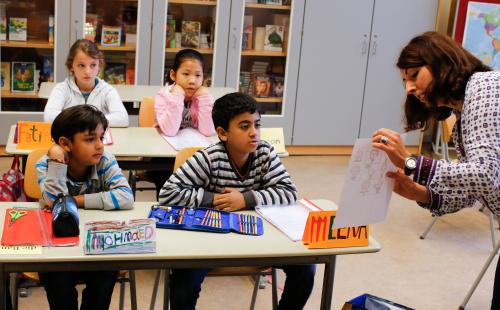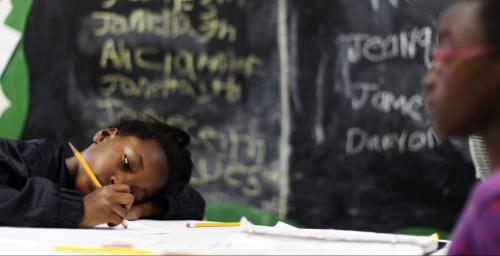As the school year begins, many of the world’s primary and secondary education systems face unprecedented challenges in meeting students’ academic needs. Financial strain and uncertainty from the pandemic coupled with the need for social distancing have undermined the role of traditional classrooms in student learning and increased the burden on parents and caregivers at home.
Even before the pandemic, the United States struggled with a stratified, unequal education system in which millions of students were behind grade level. Today’s rapid shift toward internet-based learning has risked further exacerbating inequality across racial, class-based, and geographic lines, underscoring how many students continue to lack access to the basic technology that is foundational to remote education. The magnitude of these challenges has augmented the need to urgently identify and scale cost-effective solutions to help to ensure that students do not experience learning losses that could last a lifetime.
When it comes to interventions that can help students get back on track, tutoring—defined here as one-on-one or small-group instructional programs—readily comes to mind. As educators will attest, tutoring ranks among the most widespread, versatile, and potentially transformative instruments within today’s educational toolkit. Long before the advent of the contemporary education system, scholars had instructed students individually and in small groups, with more formal tutoring interventions experiencing a renaissance in the mid-1980s. But what promise does tutoring hold in addressing today’s learning crisis?
In a recent working paper and accompanying executive summary, we look at randomized field experiments of K-12 tutoring in high-income countries. Students who end up in tutoring programs are typically different than those who do not, even at the onset of the program. In observational studies, it is therefore difficult to determine the impacts of tutoring programs by simply observing students’ educational trajectories before and after tutoring. With randomized studies, however, we can compare two groups that are similar on average before participating in a program and attribute any differences in learning outcomes after the program solely to tutoring.
We found that tutoring is remarkably effective at helping students learn, with over 80% of the 96 included studies reporting statistically significant effects. Averaging results across the studies included in this analysis, we found a pooled effect size of 0.37 standard deviations. In other words, with the help of tutoring, a student at the 50th percentile would improve to the 66th percentile. In the field of K-12 education research where there is little agreement on what works, these findings are remarkable not only for their magnitude but also for their consistency. The evidence is clear that tutoring can reliably help students catch up.
But it is not enough to know that tutoring can help. Faced with limited resources, educators and policymakers must also understand which tutoring models are most cost-effective and for which students. Tutoring programs vary widely over a range of characteristics, from tutor type, setting, frequency and duration, subject, curriculum, and pedagogical approach. Several key lessons emerged from our review:
- Who does the tutoring matters a great deal. Tutors in the studies included fell into four main categories: teachers; professional tutors like school staff members, education students, and service fellows; nonprofessional tutors like community volunteers; and parents or other caregivers. Teacher and professional tutoring programs were more effective than nonprofessional and caregiver programs. Teachers and, to a lesser extent, professional tutors typically have more training than nonprofessional volunteers and parents, which makes these models substantially costlier but also expected to yield larger effects. Many of the less effective programs used parents as tutors or took place after school. In both cases, it may have been difficult to ensure consistent implementation of the tutoring curriculum.
- Professional tutor models are a relatively cost-effective model to consider for potential scale-up. Professional tutoring programs were only marginally less effective than teacher tutoring programs, but substantially less expensive. A case in point is Saga Tutoring, a model developed and implemented by a nonprofit working in collaboration with public school systems to provide high-dosage math tutoring to high school freshmen and sophomores. An evaluation of the program as implemented within low-income public schools in Chicago found effects of an extra one to two years’ worth of math beyond what they would have been expected to learn in the absence of the program. Researchers argue that the program achieved substantial impacts even using minimally trained service fellows because tutoring is a skill that is unique from classroom teaching, and can be cultivated separately, at a lower cost, and within a relatively brief time period. Scale-up of Saga and similarly effective programs could produce a considerable reduction in disparities within the US educational system and likely require fewer resources than teacher-based tutoring programs.
- The effects of tutoring programs tend to be strongest among students in earlier grades. Younger students (early elementary) also tend to benefit more from a high frequency of tutoring sessions than older students (late elementary), which may be related to the role that repetition plays in early learning. Reading tutoring is relatively more impactful in early years while math tutoring showed relatively stronger impacts in the upper elementary years. Although fewer programs were evaluated at the secondary level, programs like Saga indicate that tutoring can still be effective for high school students.
- Variation aside, tutoring programs tend to exert strong positive learning effects across a wide range of program characteristics—although critical questions remain on the impact of new and large-scale tutoring models. Future research will be vital to ensuring success as programs scale up, come into contact with increasingly diverse student populations, and run into the challenges that inevitably emerge when coordinating large-scale social programs. One critical area for study—both in light of the recent COVID-19 pandemic and longer-term trends toward the increasing use of education technology—is the extent to which internet-based tutoring can maintain the powerful effects of in-person tutoring. While substantial investment may be required to launch and calibrate internet-based tutoring programs, savings associated with in-person tutoring—such as transportation costs—may reduce the cost side of the ledger drastically in the long run. Integrating computer-assisted learning with less frequent tutor support offers a more scalable approach to personalized learning assistance that is worth exploring and evaluating further.
Amid widespread school disruptions, there is growing interest in tutoring as a national solution to combat COVID-19 learning loss. As one example, the Center for American Progress recently proposed the creation of an Opportunity and Counseling Corps to hire tens of thousands of recent high school graduates, college students, and other community members to help serve students in high-poverty schools through tutoring.
Our review points to the proven capability of well-targeted tutoring programs to reduce long-standing educational disparities that have been aggravated by the COVID-19 pandemic. In making strides toward educational equity, education leaders should expand the use of tutoring as a reliable, workhorse tool in ongoing efforts to cultivate a more equitable society.






Commentary
Tutoring: A time-tested solution to an unprecedented pandemic
October 6, 2020